Today we are travelling to South America and Japan. One journey I will take only once, the other I can’t wait to take again.
The Colombian road movie Los Viajes del Viento has two strengths that make up for many of its conventional traits: It never descends into a too typical South American sentimentality and it has the luxury of taking place in a geography that is seldom seen on films. The story is about an old, taciturn accordion master who recently lost his wife, and the young boy who may be his son. The old master wants to travel across the entire country in order to give back his accordion to his master. As legend will have it, he once won the instrument in a duel with the devil. The boy sees apprenticeship with the old man as his only possibility to make something of himself and thus follows his unwilling companion stubbornly through some spectacular landscape and hairy situations.
 While beautiful to look at, the film didn’t really stand out in any particular way. You could substitute the old accordionist with, say, a kung fu master, or a literature professor, or any old sage with a special gift to impart on the young, and the basic story would pretty much be the same. And in the history of films, God knows this has been done again and again. The accordion only really comes to the fore in an early duel with a younger braggart in a music contest. Like the rapper’s duels in Curtis Hanson’s 8 Mile, the accordion contest consists in psyching out one’s opponent by rhyme and insult while sticking to the chosen accordion tune. It may sound far fetched, but this part of the film really worked.
While beautiful to look at, the film didn’t really stand out in any particular way. You could substitute the old accordionist with, say, a kung fu master, or a literature professor, or any old sage with a special gift to impart on the young, and the basic story would pretty much be the same. And in the history of films, God knows this has been done again and again. The accordion only really comes to the fore in an early duel with a younger braggart in a music contest. Like the rapper’s duels in Curtis Hanson’s 8 Mile, the accordion contest consists in psyching out one’s opponent by rhyme and insult while sticking to the chosen accordion tune. It may sound far fetched, but this part of the film really worked.
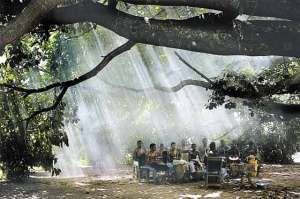 The travelogue, or road movie, is often an excellent way of highlighting a country’s geography and supporting the local tourist industry. Often, the tourist industry will help finance the film if the country is represented as a series of tourist vistas. This being Colombia, I’m not convinced that the ploy will be entirely successful, but we, the audience, win anyway. Especially since most of us will not get the chance – or take the chance – of visiting the country, I can’t think of a better way to be able to experience Colombia’s breathtaking natural vistas than in the comfort of the cinema chair, where the most immediate danger is an aneurysm triggered by some popcorn-munching moron by our side.
The travelogue, or road movie, is often an excellent way of highlighting a country’s geography and supporting the local tourist industry. Often, the tourist industry will help finance the film if the country is represented as a series of tourist vistas. This being Colombia, I’m not convinced that the ploy will be entirely successful, but we, the audience, win anyway. Especially since most of us will not get the chance – or take the chance – of visiting the country, I can’t think of a better way to be able to experience Colombia’s breathtaking natural vistas than in the comfort of the cinema chair, where the most immediate danger is an aneurysm triggered by some popcorn-munching moron by our side.
 Ultimately, the film is worth seeing for its depiction of nature and the very varied geography – or geology. The stone formations towards the end were a sight to behold, as was the endless salt flats, the village built almost on the lake itself, and the Indian village atop a mountain. I have not seen exactly these sights before and felt fortunate to witness them in this way. The film also strikes up some laconic humoristic moments and I did chuckle a time or two. As for the main plot, I didn’t feel that it resolved itself entirely satisfactorily, but, as is my habit in these posts about films that most have not yet seen, I shan’t be spoiling the end here. The titular symbol of the travelling wind has a double bottom, referring both to the literal wind that has shaped the country and the various wind instruments. There is a scene where the wind blows through a piece of wood with a whistling sound, perhaps telling us that the tradition of these men has its roots in nature itself, in a time before Man, and that all we contribute are complications of that theme.
Ultimately, the film is worth seeing for its depiction of nature and the very varied geography – or geology. The stone formations towards the end were a sight to behold, as was the endless salt flats, the village built almost on the lake itself, and the Indian village atop a mountain. I have not seen exactly these sights before and felt fortunate to witness them in this way. The film also strikes up some laconic humoristic moments and I did chuckle a time or two. As for the main plot, I didn’t feel that it resolved itself entirely satisfactorily, but, as is my habit in these posts about films that most have not yet seen, I shan’t be spoiling the end here. The titular symbol of the travelling wind has a double bottom, referring both to the literal wind that has shaped the country and the various wind instruments. There is a scene where the wind blows through a piece of wood with a whistling sound, perhaps telling us that the tradition of these men has its roots in nature itself, in a time before Man, and that all we contribute are complications of that theme.
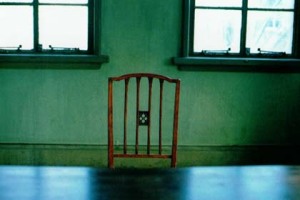 Hirokazu Kore-eda has made some seven films, not including his TV-work and some short films. Unfortunately not all of these are readily available in the west. His first film, Maborosi, an Ozu-style examination of a young widow trying to find a new lease on life after the loss of her husband , had a limited international run. But it was his second feature, the often wonderful After Life, which made him into a household name, if that house was an art house. (Yes, I know, bad pun…) In 2001 he made Distance, perhaps inspired by the gas attacks of a suicide cult in Japan; the Aum cult‘s nerve gas attack on the city’s subway system. Then came Nobody Knows, which got a wider release and was nominated in Cannes and won a number of Asian awards. The story of a group of children left to their own devices after their mother takes off, was a masterpiece of naturalistic acting. Kore-eda directed over almost two years, and the children visibly live in the film. There are scenes in Nobody Knows that should break most hearts that are not already irredeemably broken. In 2006, two years after Nobody Knows, he made Hana, about a samurai who doesn’t really want to be a samurai. He is no good at fighting and wishes he could spend his days helping the poor people of the village in which he takes up residence. His very latest film is Air Doll, about a blow up sex doll that turns human Pinocchio-style. I have not seen this yet, but those that have, comment that it is remarkable in that the film never is exploitative, nor even is interested in the sexual aspects of this offbeat story. The film is more about what it means to be human and the innocence of the non-human in comparison. The first thing the doll learns after becoming human with a beating heart, is to lie.
Hirokazu Kore-eda has made some seven films, not including his TV-work and some short films. Unfortunately not all of these are readily available in the west. His first film, Maborosi, an Ozu-style examination of a young widow trying to find a new lease on life after the loss of her husband , had a limited international run. But it was his second feature, the often wonderful After Life, which made him into a household name, if that house was an art house. (Yes, I know, bad pun…) In 2001 he made Distance, perhaps inspired by the gas attacks of a suicide cult in Japan; the Aum cult‘s nerve gas attack on the city’s subway system. Then came Nobody Knows, which got a wider release and was nominated in Cannes and won a number of Asian awards. The story of a group of children left to their own devices after their mother takes off, was a masterpiece of naturalistic acting. Kore-eda directed over almost two years, and the children visibly live in the film. There are scenes in Nobody Knows that should break most hearts that are not already irredeemably broken. In 2006, two years after Nobody Knows, he made Hana, about a samurai who doesn’t really want to be a samurai. He is no good at fighting and wishes he could spend his days helping the poor people of the village in which he takes up residence. His very latest film is Air Doll, about a blow up sex doll that turns human Pinocchio-style. I have not seen this yet, but those that have, comment that it is remarkable in that the film never is exploitative, nor even is interested in the sexual aspects of this offbeat story. The film is more about what it means to be human and the innocence of the non-human in comparison. The first thing the doll learns after becoming human with a beating heart, is to lie.
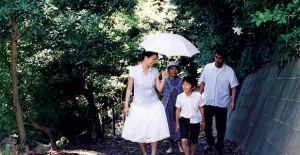 This lengthy introduction is spurred by my absolute satisfaction with Kore-eda’s penultimate film, made in 2008, and shown this day in the BIFF-festival. Still Walking is perhaps the first perfect film I’ve seen this year. I really can’t find any faults with it. The only film coming near it in quality is the Swedish Burrowing, which I spoke of in a former post. The two films have in common that they are influenced by other directors. In Kore-eda’s case, the spectre of Japanese master, Yasujirō Ozu, is present, but not overwhelming, while in Burrowing, Terrence Malick is perhaps an even more present godfather.
This lengthy introduction is spurred by my absolute satisfaction with Kore-eda’s penultimate film, made in 2008, and shown this day in the BIFF-festival. Still Walking is perhaps the first perfect film I’ve seen this year. I really can’t find any faults with it. The only film coming near it in quality is the Swedish Burrowing, which I spoke of in a former post. The two films have in common that they are influenced by other directors. In Kore-eda’s case, the spectre of Japanese master, Yasujirō Ozu, is present, but not overwhelming, while in Burrowing, Terrence Malick is perhaps an even more present godfather.
The majority of Still Walking takes place within 24 hours, but including the epilogue, the time covered is three years. The real scope of the film, however, reaches much longer, as both the past and the future is so implicit in these 24 hours, that the film nears an almost general understanding of the human situation, particularly our place in the everlasting links between generations, from the very first to the last. I was most impressed by the way in which the director achieved this generality from a very specific time in a specific family.
 A man who has just lost his job brings for the first time his wife, who is a widow, and her son to the annual family reunion. He clearly is not on good terms with his mother and father; “you should call your mother more often“, the father tells him. “I can’t stand listening to all her complaints“, the son answers. The father is a retired doctor who feels useless and socially in a no-man’s land, as he hasn’t anyone to continue his practice, and therefore must still play the role of village doctor himself, even though he is not up to it.
A man who has just lost his job brings for the first time his wife, who is a widow, and her son to the annual family reunion. He clearly is not on good terms with his mother and father; “you should call your mother more often“, the father tells him. “I can’t stand listening to all her complaints“, the son answers. The father is a retired doctor who feels useless and socially in a no-man’s land, as he hasn’t anyone to continue his practice, and therefore must still play the role of village doctor himself, even though he is not up to it.
Seemingly, much of the reason for the family’s strained relationship, is that the eldest son lost his life in a drowning accident many years before, while saving a young boy from the waves. This son was the father’s favourite, and is in hindsight made to have represented the hopes for the family’s future. Every time the conversation begins to run more or less easily, the mother mentions some details about the dead son, and the family is thrown back into non-communication.
The reason for the reunion, is indeed that it marks the anniversary for the son’s death. Also present here is a sister with her husband and two children, who the father finds noisy. We can only assume that had the dead son had any children, they would be just as noisy. This is a film where I don’t want to tell much about the plot, as much of the enjoyment comes from gradually piecing together the dynamics of the family and just what has gone wrong in their lives. It is never -apart from the death of the son, which paradoxically has brought them together – the big, life-changing events that make these people be who they are, what they have become. Kore-eda is a master in communicating much bigger truths by very small movements and glances. Sometimes he lets a phrase linger a bit longer than necessary in order for us to grasp not only the context of the phrase, the feeling behind it, but its consequences, insignificant as they may seem before we have the entire picture.
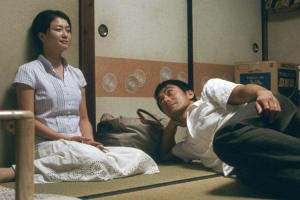 It’s a cliché, but movies is really a universal language. I almost can’t think of better ways for us to see the common humanity between us all, than by immersing ourselves in works by masterful directors like Kore-eda. I felt more recognition in this film than in any Hollywood work I can recall. Nothing sudden or life-changing happens in the film, yet I felt a wiser person after having seen it, perhaps even wanting to be a better person. In this film, the characters don’t have “arcs”, as they evidently teach in Hollywood script classes. The characters that we observe become persons more than characters, and persons, for the most part, don’t suddenly learn something or change just because they have attended a family dinner, even though a number of American Thanksgiving films want us to believe this. They go on with their lives, as best they can, or maybe not even that.
It’s a cliché, but movies is really a universal language. I almost can’t think of better ways for us to see the common humanity between us all, than by immersing ourselves in works by masterful directors like Kore-eda. I felt more recognition in this film than in any Hollywood work I can recall. Nothing sudden or life-changing happens in the film, yet I felt a wiser person after having seen it, perhaps even wanting to be a better person. In this film, the characters don’t have “arcs”, as they evidently teach in Hollywood script classes. The characters that we observe become persons more than characters, and persons, for the most part, don’t suddenly learn something or change just because they have attended a family dinner, even though a number of American Thanksgiving films want us to believe this. They go on with their lives, as best they can, or maybe not even that.
What makes the film magic to me is also a consequence of the characters not only being oblivious to their shortcomings that we as spectators can detect in them, but that they actually go on living as if there never was anything particularly important about the day we have spent with them. They just go on, or as the film says in its title, they are still walking. (This phrase also comes up in a song the grandmother insists on playing on an old record player, and which she says she has a special relationship to. The song so subtly illuminates something of the past of the characters that we don’t quite grasp it before a shot of the grandfather doctor’s later reaction. The world of memories and forgotten times that comes into light here is staggering).
The only hint of sentimentality in the film, is when the unemployed son’s voiceover comments on what has happened in the three years since the family dinner. The words are spoken very matter of factly, but that very restraint is heartbreaking in its seeming neutrality to the lives that are commented. I would love to present the importance of the grandmother’s speech about butterflies and how that speech is reproduced later on, but this is such an integral part of the experience that I must leave it for the individual viewer to assess.
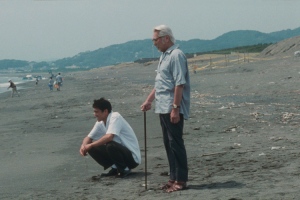 Not only is Kore-eda a master of presenting the social interaction and directing the actors into an almost completely naturalistic style, also his setting of the story deserves some mention. The film is shot in Yokosuka, Kanagawa, a seaside town with streets climbing upwards the mountainside from the sea. Seeing the wonderful locations, I couldn’t help but think of the kind of streets so typical of Studio Ghibli films, particularly Whisper of the Heart. There just is something very magnetic to me about this kind of setting, some serene quality that helps convince me that this site is ideal for the family home, a piece of childhood we all will always carry with us. The lack of the typical features of the big city helps the film to achieve a feeling not only of timelessness, but of placelessness. While very much a Japanese setting, the feeling is more general, of the kind of place that we find beautiful in hindsight, but that we had to move away from. The reasons probably felt important to us at the time, but any place we have lived in our formative years is bound to hold the ghosts of our younger selves in some way or another, still offering us possibilities of who we could have been had we by chance chosen differently.
Not only is Kore-eda a master of presenting the social interaction and directing the actors into an almost completely naturalistic style, also his setting of the story deserves some mention. The film is shot in Yokosuka, Kanagawa, a seaside town with streets climbing upwards the mountainside from the sea. Seeing the wonderful locations, I couldn’t help but think of the kind of streets so typical of Studio Ghibli films, particularly Whisper of the Heart. There just is something very magnetic to me about this kind of setting, some serene quality that helps convince me that this site is ideal for the family home, a piece of childhood we all will always carry with us. The lack of the typical features of the big city helps the film to achieve a feeling not only of timelessness, but of placelessness. While very much a Japanese setting, the feeling is more general, of the kind of place that we find beautiful in hindsight, but that we had to move away from. The reasons probably felt important to us at the time, but any place we have lived in our formative years is bound to hold the ghosts of our younger selves in some way or another, still offering us possibilities of who we could have been had we by chance chosen differently.
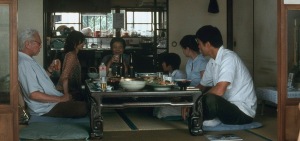 Again, all this essaying runs the risk of making the film sound as if it could be boring. It is not. In fact, there are many scenes with a wonderful understated humour, not least in the comments by and about the grandmother and grandfather. As in any real grouping of human beings, be it a family or a group of friends, there is humour to be found in familiarity. Kore-eda, being concerned with reality, has the gift of finding the humour that springs from a common humanity, from recognition, even in the idiosyncratic. The actress You (yes, that is her stage name), who played the irresponsible mother in Nobody Knows, here gets the chance to use her quirky personality in a role that never seems as it is an imposed vehicle for her brand of acting. Her presence and comedic (her voice makes me think of a Japanese Meg Tilly) timing is so strong that when she leaves the film, we suddenly feel that we have been deprived of a comforting presence in what is, after all, a scary situation; reality. Or as close to reality as we want to come.
Again, all this essaying runs the risk of making the film sound as if it could be boring. It is not. In fact, there are many scenes with a wonderful understated humour, not least in the comments by and about the grandmother and grandfather. As in any real grouping of human beings, be it a family or a group of friends, there is humour to be found in familiarity. Kore-eda, being concerned with reality, has the gift of finding the humour that springs from a common humanity, from recognition, even in the idiosyncratic. The actress You (yes, that is her stage name), who played the irresponsible mother in Nobody Knows, here gets the chance to use her quirky personality in a role that never seems as it is an imposed vehicle for her brand of acting. Her presence and comedic (her voice makes me think of a Japanese Meg Tilly) timing is so strong that when she leaves the film, we suddenly feel that we have been deprived of a comforting presence in what is, after all, a scary situation; reality. Or as close to reality as we want to come.
Offering us only a short glimpse into these characters’ lives, Kore-eda still makes us feel as if we’ve known them for a long time. His telling of this story is so effective that, even as we think that nothing very important happens, we get to learn everything that we need in order to fully grasp the situation as well as its ramifications. All the characters are given flesh and blood and lives that are not neatly solved by a contrived Hollywood script. Still, the miracle is that we don’t miss the solution, even though we’ve been indoctrinated to expect it. When all is said and done, we can leave and know that all is not said and it is not done. In fact, the way the characters are not able to come to terms with their shortcomings, or their disability to solve their conflicts, is the very thing that gives the piece such a powerful end. After this film, I really had to take some minutes to let the credits roll before I could or wanted to move. Those were good minutes.